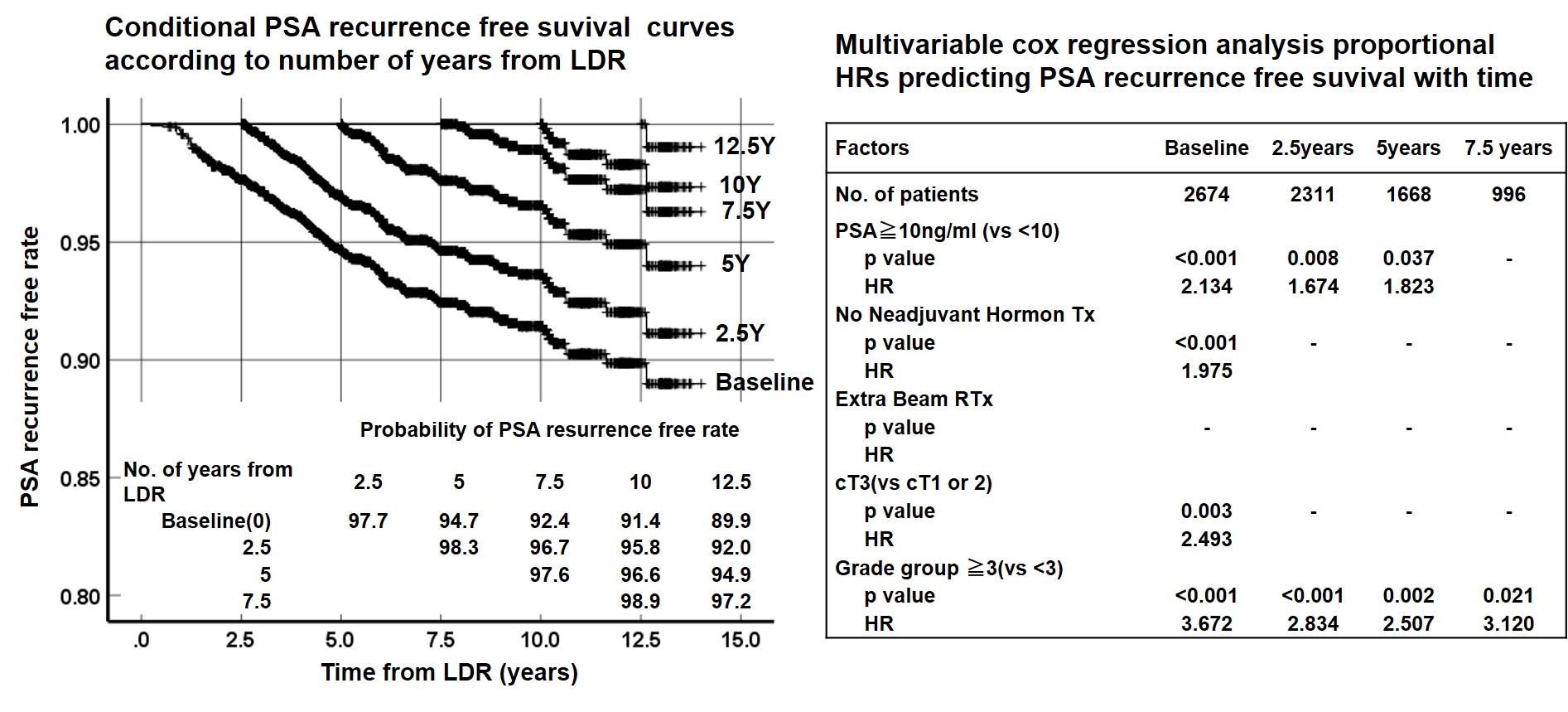Back
Poster, Podium & Video Sessions
Podium
PD13: Prostate Cancer: Epidemiology & Natural History II
PD13-05: Changes with time in prognostic factors in localized prostate cancer survivors after low-dose-rate permanent seed implant brachytherapy with iodine-125; Conditional survival analysis
Friday, May 13, 2022
4:10 PM – 4:20 PM
Location: Room 252
MASANORI HASEGAWA*, Kanagawa, Japan, SHIRO SAITO, ATSUNORI YOROZU, MONMA TETSUO, TORU NISHIYAMA, YASUTO YAGI, KEISUKE SHIGETA, Tokyo, Japan, SUNAO SHOJI, AKIRA MIYAJIMA, Kanagawa, Japan
- MH
Masanori Hasegawa
Tokai University
Podium Presenter(s)
Introduction: Urologists often encounter questions about the possibility of recurrence from patients during postoperative observation. Conditional survival analysis provides better estimates of survival time at each follow-up period. In this study, we assessed changes in conditional prostate-specific antigen (PSA) recurrence-free survival (PSARFS) rates after low-dose-rate permanent seed implant brachytherapy with iodine-125 (LDR) in patients with localized prostate cancer (PCa) and investigated how the effect of risk factors on PSA recurrence changes over time.
Methods: We identified 2674 patients with localized PCa who underwent LDR. Conditional PSARFS rates were calculated using multiple Kaplan–Meier methods. The changes in the impact of factors on PSA recurrence with time were assessed by multivariate Cox regression analysis.
Results: The median patient age was 67.9 ± 6.7 years and median follow-up period was 6.6 ± 3.4 years. PSA recurrence after LDR was detected in 173 patients (6.5%). Ten-year PSARFS rates after LDR were 91.4% at baseline. However, when we assessed the conditional PSARFS probability after LDR, the 10-year conditional PSARFS rate increased from 91.4% to 95.8%, 96.6%, and 98.9% based on 2.5-, 5-, and 7.5-year survivorships, respectively (left). Multivariate analysis revealed that no neoadjuvant hormone therapy, clinical T3, PSA=10 ng/mL, and Grade group (GG) 3 or more were independent risk factors for PSA recurrence at baseline. We found that the effects of no neoadjuvant hormone therapy, clinical T3, and PSA=10 ng/mL lost their statistical significance with time. However, the effect of GG 3 or more remained significant over time (right).
Conclusions: Conditional survival analysis revealed that the probability of PSARFS increased with time in patients with localized PCa after LDR. Longer follow up may be recommended for patients with GG 3 or more to detect subsequent PSA recurrence.
Source of Funding: None

Methods: We identified 2674 patients with localized PCa who underwent LDR. Conditional PSARFS rates were calculated using multiple Kaplan–Meier methods. The changes in the impact of factors on PSA recurrence with time were assessed by multivariate Cox regression analysis.
Results: The median patient age was 67.9 ± 6.7 years and median follow-up period was 6.6 ± 3.4 years. PSA recurrence after LDR was detected in 173 patients (6.5%). Ten-year PSARFS rates after LDR were 91.4% at baseline. However, when we assessed the conditional PSARFS probability after LDR, the 10-year conditional PSARFS rate increased from 91.4% to 95.8%, 96.6%, and 98.9% based on 2.5-, 5-, and 7.5-year survivorships, respectively (left). Multivariate analysis revealed that no neoadjuvant hormone therapy, clinical T3, PSA=10 ng/mL, and Grade group (GG) 3 or more were independent risk factors for PSA recurrence at baseline. We found that the effects of no neoadjuvant hormone therapy, clinical T3, and PSA=10 ng/mL lost their statistical significance with time. However, the effect of GG 3 or more remained significant over time (right).
Conclusions: Conditional survival analysis revealed that the probability of PSARFS increased with time in patients with localized PCa after LDR. Longer follow up may be recommended for patients with GG 3 or more to detect subsequent PSA recurrence.
Source of Funding: None


.jpg)
.jpg)